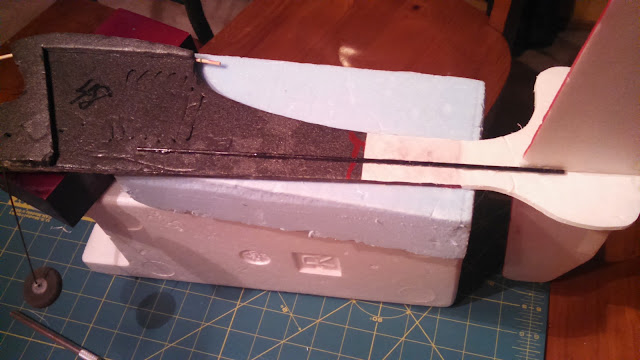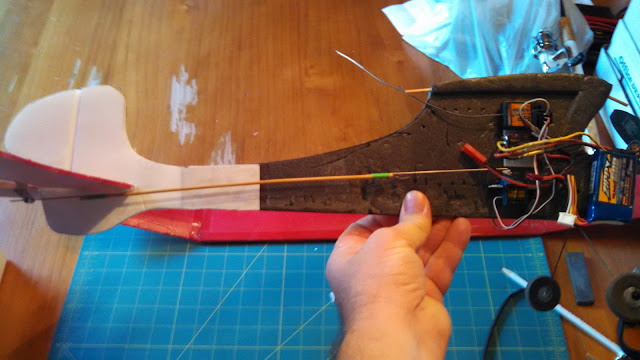This beauty was my next project!
This wing came to me from the second owner who had not actually done anything with it. He reported that the original owner had flown it with some sort of pod on top that housed the battery, electronics, and motor. The pod and what was contained were no longer with this wing. It did show signs of having been flown but was still in really good shape.
Here I started to take the covering film off of the trailing edge of the section between the elevons. I started to do this because I knew I would need to take this section out to be able to move the motor forward. I wanted to move the motor forward because I also knew it was going to be hard enough to get the CG right without the motor being so far back.
Here is a closer look after I had cut the trailing edge balsa lose. I also have the motor/prop combination that I intend to use and the start of a motor mount/firewall.
Here I'm getting an idea of how things will line up.
Here is how I originally thought everything might lay out.
To provide for some flexibility in the power system (in anticipation of crashing), I decided to use a block of stiff foam to mount the firewall. I cut out the covering film where this foam block will be glued down.
I decided to use Gorilla glue to secure this block as it would expand into the foam as well as adhere to the wood and foam of the wing. Also, Gorilla glue is more flexible than epoxy (remember the anticipated crashing?). I used the popsicle stick to help spread out the glue. I did not show these steps, but I also spritzed it with water to help activate the glue and then held everything in place with masking tape.
(Our cat Dewy is trying to get in on the action)
(Our cat Dewy is trying to get in on the action)
Here is all of the pieces glued in place. I made sure to have the motor wires run over the top just because I though it would make it easier to connect up. Also, you can see the slight up tilt in the motor. This was done to keep the thrust line pointing to the center of mass. If you do not do this with a pusher, you will get pitching up or down when applying power.
After doing some CG work (I used an online CG calculator for flying wings to come up where the CG should be for this wing. I think I used one of these: wingcgcalc and fwcg), I realized that the battery would need to mount like this to get the CG right. I centered the battery and then traced around it and dug out the foam about half an inch down. I did not want to go too far into the foam so as to maintain as much strength as possible while still providing a good battery mount. You can see that I glued some bamboo skewers into the long corners of this cutout. I also wrapped a strip of velcro around each of these. I thought that these would help reinforce the foam and help to secure the battery. This actually worked very well.
Here is a closer look.
Here the battery is strapped in.
Here I am out for the maiden flight. A friend who is a really good wing pilot got it up in the air for me and then handed the controls over after he trimmed it out. Thanks Richie!
If flew great and he was easily able to launch it and trim it out. I came down a bit hard on a landing and loosened the glue on the firewall. I just used a couple of rubber band from front to back to secure it and that is what you can see here. I did this because I was not ready to go home and really wanted to continue flying!
(Editorial Note: I am not condoning the flying of damaged airplanes in any way!)
It flew great just like this for two flights. Then I came in rough again and encountered the damaged prop and completely broken loose firewall that you can see here.
Here it is again all rebuilt and ready for another day of flying.
I have been really impressed with how durable wings can be. I have continued to fly this wing just as it is for many flights including some nasty crashes. My worst crash was at a pretty good speed into a street curb. The crash destroyed the battery and broke the hinges on one elevon and the related clevis. I have since replaced the battery repaired these and flown it again.
Thanks for stopping by my blog. Please feel free to post comments, good or bad, and be sure to come back and check for future posts.



































